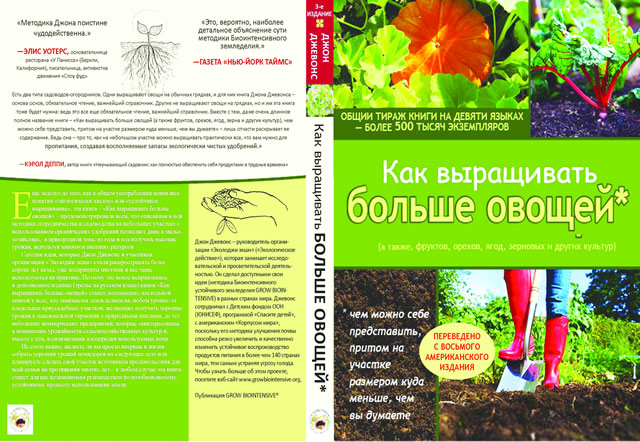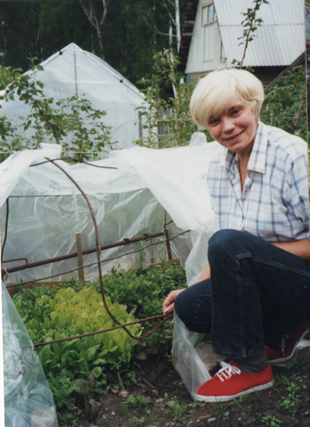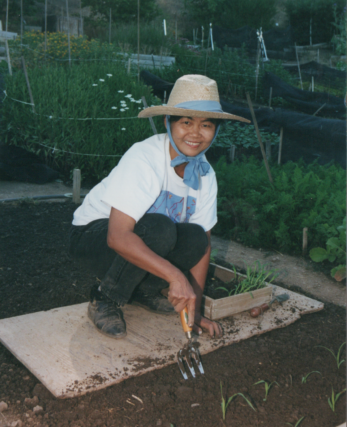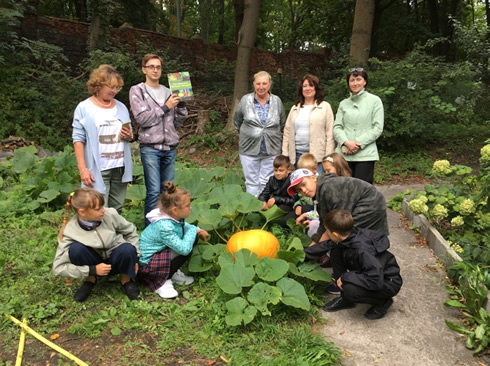Global GB Partner:
Biointensive for Russia
As I remember, my professor dad grew most of the tomatoes, green beans, sweet corn, and peas we ate during the summers in my early childhood in Wisconsin in the 1950s. My mother froze and canned the produce, often with my three siblings’ and my aid, for example shucking peas on our screened porch, or slicing the corn kernels off the cob in the kitchen. For at least two summers I worked regularly with Dad in his garden plot, under his tutelage growing corn and beans in my own rows. I sold them to the neighbors one year, earning five dollars, which at age eight seemed a princely sum! We also picked apples from our three trees – Duchess, Jonathon, and Wealthy – for Mother to bake into pies or for us to smash into applesauce. During my school, college, and young married years for the next 20 years or so, my vegetable gardening lay dormant. But as a gesture to hippie culture, my husband John Vesecky put in a garden at our rented home in Menlo Park CA in 1970. Then in 1974, he set some cherry tomato plants out in the greenhouse in back of our “semi-detached house with a bi’ o’ garden” in Leicester, England, where he taught at the local university for several years. That winter, at his request I dutifully kept his plants watered while he was back in the US for a conference. It then occurred to me that, just perhaps, I myself could sow some seeds and water them, and they might even sprout! I did so and soon, fascinated, I was watching pea tendrils miraculously growing and eventually producing flowers, pods, and … lo and behold, peas!!! I was expecting my second child, so watching new life naturally resonated inside me. Born in late spring, baby Holly turned out to be colicky, so to calm her when she woke me around dawn, I would put her in the corduroy-and-flannel carrier on my back and go out to the greenhouse to tend the veggies as the sun rose. During Holly’s and her brother Stephen’s quiet times, I worked on scientific and technical translations, making use of the Russian and French languages I had studied at Stanford. But, when not translating, I would often be out planting lettuce and carrots, and tending the tiny veggie garden along with all the rose bushes we had inherited from the former owner. I remember making the lettuce into soup, there being far too much of it!! We moved back to Palo Alto, California in 1977 when the children were still little and settled into a house within walking distance of St. Mark’s Episcopal Church, where my family and I attended the folk eucharist service with John Jeavons and his family. While cooking for a UNICEF benefit dinner I had organized, I got better acquainted with co-volunteers Betsy Jeavons and Robin Leler, who ran Ecology Action’s Common Ground Garden Supply and Education Center together. Common Ground was within easy biking distance of my home, so I started taking the Saturday morning classes offered there on all aspects of Biointensive and organic gardening by John Jeavons, Louisa Lenz, John Beeby, Carol Cox, and many other adepts. Betsy and Robin told me about John’s work in Ecology Action’s large research garden in the Stanford Industrial Park, practicing the Biodynamic/French Intensive mini-farming practices he had learned from Alan Chadwick and his apprentices at UC Santa Cruz. Then, after hearing about my educational background in languages, they invited me to visit their home and garden and meet John, who then recruited me to co-edit the French translation of the booklet “Biointensive Mini-Farming: A Rational Use of Natural Resources.” That led to my typesetting the French translation of How to Grow More Vegetables on Jean-Marie de la Beaujardière’s pre-Macintosh computer at the Xerox Palo Alto Research Center on Saturday mornings from 1980-1982. Then came the German translation, on my first home (CP/M, pre-IBM PC and Windows) computer, in 1983. The Cold War was at its height then, but that had begun to change in November 1986, when a historic youth exchange organized by the Earthstewards in Washington state took place and I helped host 21 teenagers from Siberia during their visit to the Bay Area. One of the chaperones was Viktor Yukechev, Novosti Press Agency bureau chief for Novosibirsk. An avid gardener, he gratefully accepted my parting gift of How to Grow…. in English. Viktor and I then nurtured the dream together, via post, fax, and phone, of publishing a Russian translation. The following year, I traveled to the USSR on my first citizen diplomacy tour with the Earthstewards, and shared copies of the book in English and French with Russians I met, who assured me that it would be very popular there. Hence, in Moscow with the National Council of Churches group in 1988, Viktor having sent me his phone number, I visited the chief editor of the practical books-oriented Mir Publishing House. Sure enough, the Mir editor expressed interest in publishing the book! But by the time of my third citizen diplomacy tour in 1989 (led by me), I learned that alas, competition for paper and printing resources was too great. In the following years, more publishing efforts were made, but foiled each time. Our first Ecology Action workshop with Russian participants resulted from the visit of Muscovite Vladimir Novosyolov to Willits during one of the Center for Citizen Initiatives (CCI) exchanges in 1989. Nine Muscovites hoping to acquire home and garden plots in the country, leading to vast quality-of-life improvements over their communal apartments, visited the Bay Area in 1990, and John Jeavons taught a 5-day workshop for them at Stanford University. We provided home stays in Palo Alto and environs, and they visited Willits for for a day tour of the early Jeavons Center garden. Most were journalists, so Biointensive got media attention in the USSR that year. Back to How to Grow: Years later in 1992, Viktor Yukechev sent us the translation he had commissioned in Novosibirsk/Akademgorodok, and we were able to obtain US Peace Corps funding for its editing, typesetting (on borrowed Macintosh computers in Palo Alto and at Stanford), and proofreading. We were not yet using email by then, and there were only 14 phone lines into the USSR. So, due to the greater ease of phone and fax communication with Moscow, publication finally was accomplished there with the aid of Boris Khersonski, who was putting out books on business topics in Russian at the time with Sharon Tennison’s CCI. The Peace Corps contributed to the effort by pre-paying $10,000 for 400 copies of the book for their volunteers in Russia, to share in the communities where they taught English and business methods for the eleven years ending in 2003. Thus, I was able to pay my excellent team for editing and proofreading, and myself for preparing the camera-ready copy with an early Apple layout program and physical paste-ups of the illustrations. Next, Liza Loop, another citizen diplomat and Earthsteward, and I created Biointensive for Russia (BfR) as a nonprofit project fiscally supported by LO*OP Center, the 501(c)3 organization she directed. The Moscow publisher’s marketing effort seemed weak, so our initial effort was to give Americans the chance to present a copy to Russians they had befriended during the era of citizen diplomacy exchanges. We mailed out a brochure requesting $10 and a Russian name and address, then faxed the names we received to Elena Kotikova in Moscow. Elena carried them via Metro to Valentina Fessenko’s Moscow apartment where our 500 books were stored, and over the subsequent two years Valentina mailed over 300 of them to addresses from Vilnius to Vladivostok. She received many grateful letters, which she kindly saved for me and which I treasure to this day. Ekodom was largely composed of physicists who were testing home-building designs for living autonomously off the grid, using solar and wind power produced on-site, with the best possible thermal wall insulation. The concept of growing one’s own vegetables Biointensively using only locally available inputs was enthusiastically supported by Akademgorodok’s academic community, which included many scientists who — as did a large proportion of Russians — grew their own vegetables and fruit in their “dacha” gardens. US Agency for International Development (USAID)-funded grants were being offered at the time by the Institute for Social Action and Renewal (ISAR) in Washingrton, so I traveled to Novosibirsk for a two-week visit to get acquainted with Ekodom’s president Igor Ogorodnikov and director Aleksandr (Sasha) Avrorin and begin the grant-writing process. On my return I worked with Larissa to complete the proposal, while hosting her in Palo Alto. By this time BfR had been re-registered as a project fiscally supported by Ecology Action, and in due course we were awarded a $25,000 Ecology Action/Ekodom cooperative grant. The grant activities included workshops, a major experiment, and translation and publication of EA booklets, for which a copying machine was purchased. Larissa and Sasha taught a workshop in January 1996 that was attended by 25 teachers, journalists, and scholars from the Novosibirsk area, plus one from northwest Russia, one from Tbilisi, Georgia, and an American working for Rodale from Moscow. The experiment was ambitious, directed by Larissa with many scholars and Ekodom friends participating, growing several different crops on land adjacent to their experimental dwelling. Higher yields were, in fact, recorded from the double-dug beds; the report was published by Ecology Action and is available to this day. Larissa and Sasha continued to teach in Siberia and western Russia, until it became too difficult due to their new, salaried careers. The grant also covered most expenses for three more teachers from St. Petersburg to attend a workshop in Willits in March 1995. One of the three emigrated to the US, but Albina Kochegina and Natasha Krestiankina each taught middle-school students in the Young Naturalist extracurricular program in St. Petersburg, at its large, centrally located garden plot and at a suburban school with large greenhouses. That same year, I attended the ISAR-organized, USAID-funded EcoForum held near Kiev that brought 200 NGO activists from the former Soviet Union together with 40 from the US. Dr. Ludmila Zhirina of the NGO VIOLA attended the session where I presented GROW BIOINTENSIVE sustainable mini-farming (GB); we met afterwards and have worked together ever since. Aided by MacArthur Foundation travel grants and Ecology Action, BfR hosted five former Soviets, from Zhambyl (Kazakhstan), Irkutsk (Siberia), Novo-Sin’kovo (near Moscow), and Krasnodar krai and Bryansk in Western Russia, for a three-day GB workshop in Willits in 1996. All returned to teach, but notably, Ivan Antiushin from Novo-Sin’kovo, north of Moscow, hosted our international workshops three times at the facility he directed there, that was devoted to training teachers from agricultural colleges all over Russia. Vladimir Loginov returned to the Krasnodar region in southern Russia in 1995 to present GB in a TV series locally. He also taught GB, along with other trades, for many years to high school graduates moving on into society from orphanages. Then, funded in various ways including by USAID-funded Winrock International, BfR led or co-led five tours to Russia and Uzbekistan from 1997 to 2002. During those American GB teachers Carol Cox, Patrick Williams, Albie Miles, Daniel and Amber Vallotton, and Steve Moore, and Russians Larissa and Sasha Avrorin, conducted workshops in 12 cities including Nukus, Karakalpakstan, Uzbekistan near the Aral Sea, and Novo-Sin’kovo near Moscow. We also brought more teachers from Russia and Central Asia to EA’s workshops in Willits: four from Bryansk, and one each from Chirchik (Uzbekistan), Komsomolsk-na-Amur. Nearly all returned home and taught, each in his or her own way and to varying degrees, in their communities. The Bryansk participants, tested the method in 1997 and 1998 and hosting a workshop with our participation in 1999. They continue teaching to this day in two organizations: the NGO VIOLA, led by Dr. Ludmila Zhirina, and the Grassroots Alliance PERESVET, led by Dr. Igor Prokofyev. Ludmila’s work is of particularly broad scope, aided by her contacts as director of environmental education for the Russian Socio-Ecological Union. We published a third Russian edition print-on-demand in the US in 2016, and subsequently in Russia in special printings, and copies were provided to our teaching network. This inspired Ludmila Zhirina’s renewed interest in sharing the method, including in the Chernobyl radiation zone in her region where she has worked extensively for over 30 years to mitigate the effects of the nuclear accident. Invited by Permaculture and Biodynamic farming educators and Waldorf schools, she has taught extensively in the northern and several other provinces of western Russia. BfR is an ongoing project, linking Russians and Americans at the veggie-roots level. We also grow vegetables and fruit for the needy at St. Andrew’s Episcopal Church, and in fact are the proud winners of the first annual Ventura County Compost Cup; see facebook.com/VCCompostCup/ ! We’re thrilled and enjoying our earliest rewards of CSA boxes of produce from Steve Sprinkel’s farm and Farmer and the Cook. If you’re anywhere near Ojai, do drop by for a visit, at the St. Andrew’s garden or in our mulberry orchard not far off. We’re happy to be able via the internet to continue not only to think, but also act globally, while also acting locally. Whether or not you‘re a gardener, if you’re interested and time permits, please write to establish contact, and/or for occasional updates! Carol Vesecky
♥
top | Newsletter Home |Table of Contents| Archive
|


 The next year, John Jeavons suggested I invite Russian gardeners willing to teach others to one of his biannual 3-day workshops in Willits. Many responded to the invitation Elena in Moscow sent out via the internet email for us, but only one – Larissa Avrorina from Ekodom in Novosibirsk’s Akademgorodok – ultimately succeeded in getting a visa and attending the workshop, plus a one-month internship at Ecology Action in Willits.
The next year, John Jeavons suggested I invite Russian gardeners willing to teach others to one of his biannual 3-day workshops in Willits. Many responded to the invitation Elena in Moscow sent out via the internet email for us, but only one – Larissa Avrorina from Ekodom in Novosibirsk’s Akademgorodok – ultimately succeeded in getting a visa and attending the workshop, plus a one-month internship at Ecology Action in Willits. Environmentalist and Russia scholar Fran Macy was also there, and I attended a session he co-led on Deep Ecology/the Work That Reconnects that was being developed by his wife, Joanna Macy. Fran and Joanna had already met Ludmila during their 1992 visit to Bryansk and Novozybkov in Russia’s Chernobyl radiation zone, where Joanna originally used the Elm Dance in her grief work; see
Environmentalist and Russia scholar Fran Macy was also there, and I attended a session he co-led on Deep Ecology/the Work That Reconnects that was being developed by his wife, Joanna Macy. Fran and Joanna had already met Ludmila during their 1992 visit to Bryansk and Novozybkov in Russia’s Chernobyl radiation zone, where Joanna originally used the Elm Dance in her grief work; see  Irina Kim, from Chirchik, UZ, taught a two-year high school program on GB mini-farming and soil science and, supported by BfR, led her student “activists” to remote villages in nature reserves to teach over a period of ten years. She also taught workshops in Kazakhstan and Kyrgyzstan. All of these activities and our ecotours (in 2001, 2005, and 2007) are described in our roughly annual (until 2011) newsletters, which can be read online
Irina Kim, from Chirchik, UZ, taught a two-year high school program on GB mini-farming and soil science and, supported by BfR, led her student “activists” to remote villages in nature reserves to teach over a period of ten years. She also taught workshops in Kazakhstan and Kyrgyzstan. All of these activities and our ecotours (in 2001, 2005, and 2007) are described in our roughly annual (until 2011) newsletters, which can be read online  Some of these activities are portrayed at
Some of these activities are portrayed at 
